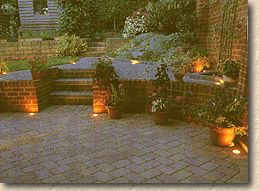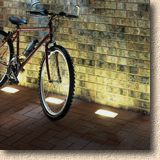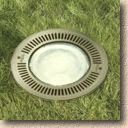Introduction:
From simple point illumination for residential paths and patios to spectacular commercial schemes that are used to light up buildings, landscape features or just to provide ambient light for pedestrians and traffic after dark, lighting has now become a key component of good design for many paving projects.
Lighting is used to provide a number of benefits including:
- Safety - illuminating pathways, indicating hazards, such as steps, or marking safest routes
- Amenity - providing light to enable social interactions (usually involving alcohol!) to continue after nightfall
- Atmosphere - pools of light are used create a comfortable or dramatic effect
Types:
There are many different types of lighting unit that can be used to illuminate a paved area. They might be divided into three broad categories:
- - Wall/post mounted (PIR security lights, spot lights, street lamps)
- - Floor/spike mounted (spot lights, path markers)
- - Recessed fittings ( lights that are sunk into paving units or set into the ground)
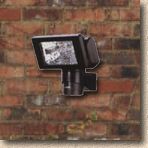
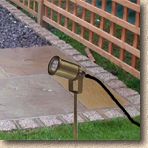
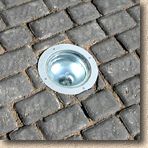
The remainder of this page considers only the recessed units that can be fitted into pavements or individual paving units.
Safety
All lighting units need to be certified as suitable for outdoor use, which generally means they must be weatherproof. Many are low-voltage, and so require a transformer to step down the voltage, although some types use the 240v domestic standard.
Many units and systems are designed to be installed by competent DIYers, but, if there are any doubts or uncertainties, a properly qualified electrician should be consulted.
It is beyond the remit of this website to go into all the technicalities of electrical installation and safety with regard to outdoor appliances and fitting, so what follows is a general overview of the type of lighting units that are available and their potential uses, rather than a comprehensive guide to installation.
Installation:
It's worth noting that any cables or ducting that will be required to power the lighting should be installed before constructing the pavement. We prefer ducted cables, as they can be replaced or supplemented at will without needing to rip up the paving. On site, the usual practice with suitable systems is to install the cables/ducting and leave 'tails' projecting at the required sites, with the actual lighting units being fitted once the paving has been completed.
Installation of a medium-height lighting column to a residential driveway is documented on a separate page .
Recessed Fittings:
Recessed Pavement Lights can be roughly sub-divided into 4 separate categories:
- LEDs - mainly for home and garden use
- Small encapsulated units - mainly residential paths and patios
- Medium encapsulated units - for driveways and other low traffic areas
- Commercial units - for streetscapes and larger projects.
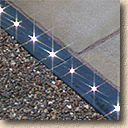
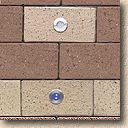
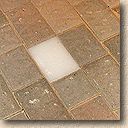
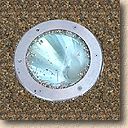
LEDs:
LEDs are the cheapest option, coming in at around £18-£30 per unit, plus the cost of the transformer. The great advantage of LEDs is that they are maintenance-free, with a long-life (reckon on 20 years at normal levels of usage) and are cool to the touch, making them supremely safe for those areas where kids and pets may be present.
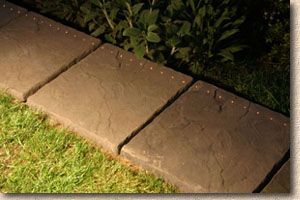
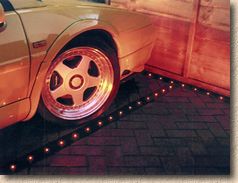
They are small, low-voltage units, usually daisy-chained together and available in a good range of colours, enabling all sorts of fancy/weird lighting effects to be created.
They are usually supplied pre-fitted to a 'standard' paving unit, often a riven-effect wet-cast flag, although they can be fitted to other units on request. They provide small 'points' of light, rather than generating ambient lighting, and are therefore best suited to marking the edge of pathways, step risers or similar 'hazards', or they may be used to create interesting features within paved area. They do not provide sufficient illumination to enable normal leisure activities after dark.
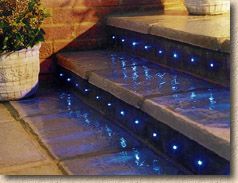
All the LED images in this section feature products from VIPstones , a British-based company that can supply an impressive range of paving LEDs.
Encapsulated Units - small:
These small units are the next step up the lighting ladder and are small enough to be fitted to individual paving units. Again, they are generally low-voltage, and usually feature a cluster of LEDs within each unit which provide more light than the simple single-LED units illustrated above. They offer all the advantages of LEDs mentioned above, but generate more light per unit, making them somewhat more versatile.
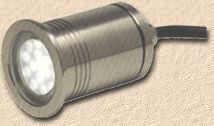
There are also fibre-optic systems, that rely on the latest technology to deliver light from a single source to a number of points around the pavement, and to create intriguing or spectacular effects with changing colours, twinkling effects or full-scale lighting shows.
Obviously, this extra versatility comes at a cost, and prices we've monitored range from £25 for 25mm diameter low-output LED units to £150 or more for 50mm diameter brighter units. The fibre-optic systems can run into several thousand pounds for a basic 4 light set-up, so they are not for the faint-hearted!
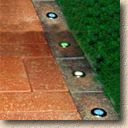
Although some suppliers are providing these units pre-fitted to selected pavers, they are easily fitted to more or less any brick, block, flag, kerb or edging, and they're tough enough to be trafficked.


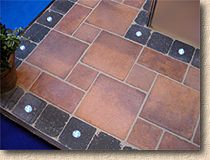
Small encapsulated units (UniLEDs) from PLM Brickcraft
Encapsulated units - medium:
These units tend to rely on traditional lighting bulbs inside a weatherproof/waterproof fitting, rather then the LED technology used in the smaller units. Consequently, the light they provide is stronger and can be used to create substantial pools of ambient light, making them ideal for lighting whole areas of pavement or even to uplight landscape features such as trees, walls or other constructions.

Again, extra illumination costs extra shillings, and individual fittings can easily come in at over £150. However, there are some sytems provided by paving manufacturers that are designed to replace whole paving units (such as the " Drivelight " from Marshalls ) that are available at a much more realistic price.

Commercial units:
These may be thought of as large, encapsulated units. They are most commonly used on commercial or public hardscape schemes, where the intention is to provide illumination on a par with more traditional forms of street lighting, albeit with a sense of style, which might incorporate specific colours, or even a colour-changing routine, or be directed at a particular feature or building.
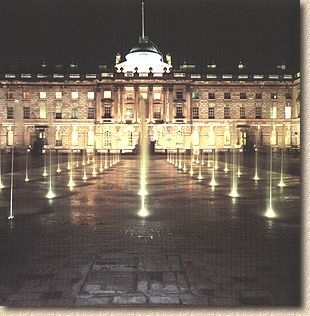
Generally speaking, use of this type of lighting unit is designed in advance by a specialist lighting technician to make best use of the space and to illuminate the main features in a stylish and entertaining way.
These costly units (£250+) are generally wired into the street lighting circuit, rather than using a LV system, and therefore, they should be wired up by a qualified electrician.
Further information:
- Acheson-Glover - Irish-based distributor of UniLED lighting system
- Brett - supplier of the Glo-light range
- Landscapeplus.com - Trade only supplier of lighting and other landscape accessories
- Marshalls - supplier of Drivelight and Living Lights
- Noral - Specialist in landscape lighting
- PLM Illumination - LEDs and other lighting solutions for pavements
- VIPstones - ready fitted LED specialist

